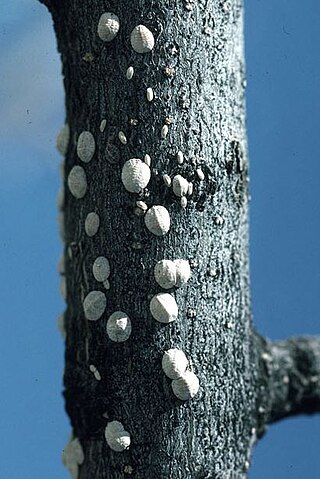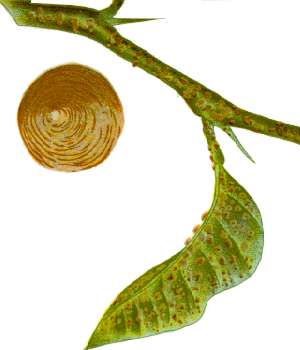Scale or scales may refer to:
A bacteriome is a specialized organ, found mainly in some insects, that hosts endosymbiotic bacteria. Bacteriomes contain specialized cells, called bacteriocytes, that provide nutrients and shelter to the bacteria while protecting the host animal. In exchange, the bacteria provide essentials like vitamins and amino acids to the host insect. Bacteriomes also protect the bacteria from the host's immune system, with insects secreting antimicrobial peptides such as the coleoptericin secreted by weevils to keep bacteria within the bacteriome.

Aonidiella aurantii or red scale is an armored scale insect and a major pest of citrus. It is thought to be a native of South China but has been widely dispersed by the agency of man through the movement of infected plant material. In the United States it is known as California red scale. It was first found in California between 1868 and 1875, apparently brought there on planting material imported from Australia.

Diaspididae is the largest family of scale insects with over 2650 described species in around 400 genera. As with all scale insects, the female produces a waxy protective scale beneath which it feeds on its host plant. Diaspidid scales are far more substantial than those of most other families, incorporating the exuviae from the first two nymphal instars and sometimes faecal matter and fragments of the host plant. These can be complex and extremely waterproof structures rather resembling a suit of armor. For this reason these insects are commonly referred to as armored scale insects. As it is so robust and firmly attached to the host plant, the scale often persists long after the insect has died.

The shortnose gar is a primitive freshwater fish of the family Lepisosteidae. It is native to the United States where its range includes the Mississippi and Missouri River basins, ranging from Montana to the west and the Ohio River to the east, southwards to the Gulf Coast. It inhabits calm waters in large rivers and their backwaters, as well as oxbow lakes and large pools. It is a long, slender fish, brown or olive green above and whitish below. It typically grows to about 60 cm (24 in) and is armored by rows of interlocking, rhomboidal ganoid scales.
Abgrallaspis cyanophylli, the cyanophyllum scale, is one of nine species of the Abgrallaspis genus of armored scale insects. It is a pest throughout the Tropical South Pacific, attacking fruits and ornamental plants.

Halimococcidae is a family of scale insects in the order Hemiptera. Members of the family are commonly known as pupillarial palm scales or halimococcids. Most species are found on the leaves of palm trees where they suck sap, but some species occur on Pandanus. The family was named by Brown and McKenzie in 1962 and includes five known genera and twenty one species.

Lecanodiaspididae is a family of scale insects commonly known as false pit scales or lecanodiaspidids. Members of this family come from all parts of the world but are most numerous in the Far East.

Aspidiotinae is a large subfamily of armored scale insects, with 193 genera.

Aulacaspis yasumatsui, or cycad aulacaspis scale (CAS), is a scale insect species in the genus Aulacaspis that feeds on cycad species such as Cycas revoluta or Dioon purpusii. Other common names include the cycad scale, the sago palm scale, and the Asian cycad scale. This is a serious pest of cycads which can kill its host plant.

Pinnaspis, first described by Theodore Dru Alison Cockerell in 1892, is a genus of scale insects belonging to the family Diaspididae, or armored scale insects. There are currently 42 species within the genus Pinnaspis.

Parlatoriini is a tribe of armored scale insects. Takagi (2002) indicated that the Parlatoriini appear to be phylogenetically related to the Smilacicola and the Odonaspidini. Takagi went on to say about the tropical east Asian Parlatoriini that, The current classification of their genera may be largely tentative because the adult females are simple-featured and much modified owing to the pupillarial mode of life, and also because the second instar nymphs are generally similar among parlatoriines, whether the adult females are pupillarial or not. Andersen found that separating out pupillarial forms into a separate subtribe, Gymnaspidina, was counterproductive, as being non-dispositive.
Furcaspidina is a subtribe of armored scale insects, traditionally regarded as part of the Aspidiotini. While the subtribe Furcaspidina was not mentioned in Takagi's 2002 study, the Aspidiotini were not deemed as problematical as the Diaspidini and Lepidosaphidini. In 2006, Williams reduced the Furcaspidina to a single genus, with about twenty-eight species. Andersen in 2009 suggested that the Furcaspidina belonged in an expanded subfamily of Diaspidinae; however, additional analysis suggests that the furcaspids are better placed in a distinct, but laterally equivalent subfamily to the Diaspidinae, possibly together with the gymnaspids which Borchsenius placed in the Aspidiotinae subfamily.
Diaspidina is a subtribe of armored scale insects. It occurs mostly in the Americas and Africa, with a few species in tropical Asia. In the Americas Pseudoparlatoria is the largest genus, with Diaspis second; in Africa Diaspis is the largest genus. The grouping identified by Balachowsky in 1954 as the subtribe Diaspidina, are now the tribe Diaspidini.
Kuwanaspidina is a subtribe of armored scale insects. They feed on bamboo.
Rugaspidiotina is an obsolete subtribe of armored scale insects. It was established by Balachowsky in 1949 to accept those Diaspidinae which had rugaspidiotine characteristics as exemplified by genus Rugaspidiotus MacGillivray, species Rugaspidiotus arizonicus, and was moved from the Odonaspidini to the Diaspidini by Borchsenius. It was raised to tribe status as Rugaspidiotini. However, close examination of species assigned to the Rugaspidiotini showed that the rugaspidiotine characteristics convergently evolved in different groups of diaspidids. Rugaspidiotini and Rugaspidiotina are now regarded as obsolete groupings.

Aspidiotus nerii is a species of armored scale insect with the common names oleander scale and ivy scale.
Aonidomytilus crookiae is a species of scale insect in the family Diaspididae which are often referred to as "armored scale insects." It is commonly known as "St. John's Wort Scale." Originally named Nelaspis crookiae by Gordon Floyd Ferris in 1954, the taxon was moved to the genus Aonidomytilus in 1984 as the result of a 1979 taxonomic revision of the genus. Aonidomytilus multiglandulatus is a junior synonym.
Hemiberlesia lataniae, the latania or palm scale, is a species of armored scale insect in the family Diaspididae. It was first described by the French entomologist Victor Antoine Signoret in 1869 using Latania lontaroides, a species of palm tree endemic to Réunion as its host; since then, it has been found on avocado trees growing in South Africa, Australia, Israel, the United States, and on a range of other plants in many parts of the world.
Parlatoria blanchardi, the date palm scale, is a species of armored scale insect in the family Diaspididae. It is a widespread and serious pest of palms, both date palms and ornamental species.








